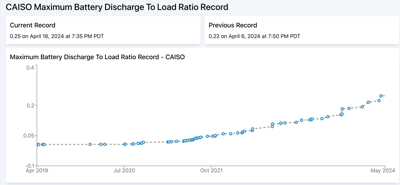Renewables Routinely Exceed Demand, Batteries Set Record on CAISO System | Regional Roundup | newsdata.com

Battery discharge on the California Independent System Operator's grid reached 25 percent of load April 16, surpassing the previous 22-percent record set just 10 days prior.
GridStatus.io
The California Independent System Operator inspired conversation on social media this week in response to a self-described data geek and a Stanford engineering professor posting comments about the percentage of emissions-free resources and batteries serving load on the system.
"Two things happened on the @California_ISO grid last night. 1) Battery storage discharge went over 6GW for the first time AND 2) Batteries were the largest source of supply," Joe Deely, a nonprofit founder and analytics consultant, wrote on X April 17.
Princeton professor and macro-scale energy systems engineer Jesse Jenkins, who leads the university's Zero carbon Energy systems Research and Optimization Laboratory, or ZERO Lab, chimed in for context. "[A]t the beginning of 2021, installed battery capacity in California was a rounding error. Now it's cranking out the equivalent power output as six nuclear reactors when grid operators and markets call," he responded in a repost of Deely's tweet.
The remarks came days after Stanford civil engineering professor Mark Jacobson on April 14 posted to X CAISO graphs showing that hydropower, wind and solar resources exceeded 100 percent of the grid operator's demand for at least 15 minutes and as much as six hours on 30 of the previous 38 days.
"This is not an anomaly. It is the new reality. The percentages will only increase each year," Jacobson said in the widely retweeted post.
CAISO spokesperson Anne Gonzales supported Jacobson's comments. "We are seeing higher percentages of renewables every spring, so this phenomenon has been building since we broke the 100-percent mark in May 2022," she wrote in an email to California Energy Markets.
Gonzales said CAISO won't have validation of the numbers for a few weeks and noted that the renewables peaks occur for a small number of hours in the year under ideal conditions. "We typically hit renewable peaks in the spring season because of mild weather reducing air conditioning and heating use, and the higher sun angle accelerating rooftop and grid-scale solar output. We tend to see records on weekends, as loads are even lower," she said.
The numbers do reflect the reality that more renewables capacity is coming on line and that CAISO operators are managing substantial amounts of carbon-free resources on the system, Gonzales said. "It's a preview of the modern, increasingly clean, reliable power grid of the future." |





